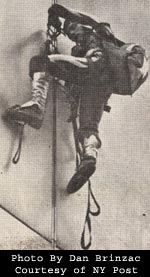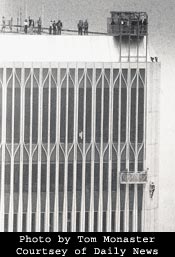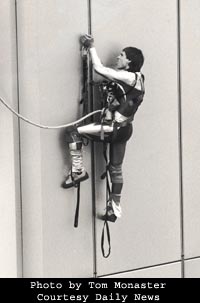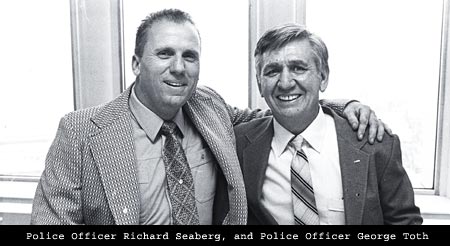|
NEAR DEATH EXPERIENCE
 The climbing harness and colorful climbing suit looked out of place as
he walked through the plaza of the World Trade Center. The small group looked up at the world famous Twin Towers. The South Tower had already been conquered back in 1977. But, that was
another man, and another climb. This time, it was to be the 110-story North Tower. Two years ago, he had scaled the 1,454-foot Sears Tower in Chicago. That climb had brought him a certain amount of
fame. He climbed five other skyscrapers and felt that the Twin Towers was "state of the art" climbing. The homemade equipment that he carried was the result of careful preparation. He had
designed metal clamps that he would use to insert into the window-washing tracks that run from the ground to the roof of the tower. He checked his equipment as his friends stood by ready to
assist him. His six-year old son watched as the small crowd of curious bystanders stood by. It was Memorial Day and the regular workforce wouldn't be in today. He carried a small American flag
and extra clamps in his backpack. The climbing harness and colorful climbing suit looked out of place as
he walked through the plaza of the World Trade Center. The small group looked up at the world famous Twin Towers. The South Tower had already been conquered back in 1977. But, that was
another man, and another climb. This time, it was to be the 110-story North Tower. Two years ago, he had scaled the 1,454-foot Sears Tower in Chicago. That climb had brought him a certain amount of
fame. He climbed five other skyscrapers and felt that the Twin Towers was "state of the art" climbing. The homemade equipment that he carried was the result of careful preparation. He had
designed metal clamps that he would use to insert into the window-washing tracks that run from the ground to the roof of the tower. He checked his equipment as his friends stood by ready to
assist him. His six-year old son watched as the small crowd of curious bystanders stood by. It was Memorial Day and the regular workforce wouldn't be in today. He carried a small American flag
and extra clamps in his backpack.
He knew that he had to act quickly before the Port Authority Police spotted him. He scaled the first thirty feet up the North Tower by using suction cups. He dropped
the cups down to his friends and inserted and locked the first clamp into place in the metal track. Each
of the clamps had nylon stirrups that he used to boost himself up the side of the building. It would be
a laborious effort. Each time he stepped up, he would have to take out each clamp, re-insert it into the narrow metal track, and then repeat the process. His life depended on the strength of the clamps and
the condition of the window-washing tracks.
The Port Authority Police noticed him a few minutes into the climb and called for the Fire
Department. A Ladder Company responded, but got there too late to intercept him. He was on his way to the top. The crowd of spectators grew larger as news of the climb spread. He now had what
he wanted. The attention of the media would be sure to follow his act.
Fame is a subject that many have written about. One comes to mind now.
"If you are ambitious of climbing up to the difficult, and in a manner inaccessible, summit of the Temple of Fame, your surest way is to leave on one the narrow path of Poetry, and follow the
narrower task of knight-errantry, which in a trice may raise you to an imperial throne."
Miguel de Cervantes (1547-1616) Don Quixote
Police Officers George Toth and Richard Seaberg, Emergency Service Truck One expected a quiet tour of duty. These two guys were experienced emergency service cops with over twenty years of service
with the NYPD. The Emergency Service cops were the most admired cops of the NYPD. They never needed to seek fame. It came looking for them.
Toth and Seaberg were on routine patrol in Lower Manhattan and were monitoring the First Division radio frequency. (The Citywide Dispatcher dispatches emergency service cops, but they also monitor
the patrol division radios). They heard the report of a man climbing the Twin Towers. They were on the scene quickly and met an excited Port Authority cop. The two Emergency Service cops grabbed
their Morrissey belts with safety lines, and raced to the bank of elevators in the Tower.
They got to the roof and examined the motorized scaffold that was used to wash the windows of the
110-story building. The scaffold was on a track that circled the rooftop and had to be positioned as close as possible to the path of the climber.
"Just activating the scaffold was a major production," Officer Seaberg said. "It took us 35 minutes to position it properly".
 The scaffold had to be physically pushed into position. The
PA cop called a maintenance worker to the roof who explained the workings of the machinery. He warned them that the device hadn't been used for a long time. He also told the cops
that the metal tracks would be a problem. As the scaffold was lowered down, the tracks were poorly aligned and would require them to use a screwdriver to allow the scaffold to be lowered.
Toth said that the scaffold was a shaky piece of equipment. It was designed for two men to lower the scaffold down the walls. There were small electric motors at each end. Toth could see
that other responding cops had set up an air bag at ground level. The bag looked no bigger than a postage stamp from the top of the tower. Officers Toth and Seaberg climbed into the flimsy
scaffold and began to lower away. Both of the cops soon found that the metal tracks were indeed in poor condition. The cops rigged safety lines between them and the scaffold. Officer
Seaberg would be the closest to the climber as they descended to meet him. The scaffold had to be physically pushed into position. The
PA cop called a maintenance worker to the roof who explained the workings of the machinery. He warned them that the device hadn't been used for a long time. He also told the cops
that the metal tracks would be a problem. As the scaffold was lowered down, the tracks were poorly aligned and would require them to use a screwdriver to allow the scaffold to be lowered.
Toth said that the scaffold was a shaky piece of equipment. It was designed for two men to lower the scaffold down the walls. There were small electric motors at each end. Toth could see
that other responding cops had set up an air bag at ground level. The bag looked no bigger than a postage stamp from the top of the tower. Officers Toth and Seaberg climbed into the flimsy
scaffold and began to lower away. Both of the cops soon found that the metal tracks were indeed in poor condition. The cops rigged safety lines between them and the scaffold. Officer
Seaberg would be the closest to the climber as they descended to meet him.
The scaffold could hold a maximum of 600 pounds. The two cops with their equipment were almost
at that limit. A third person would exceed the load capacity. The cops knew they were in danger if the climber's weight was added to the scaffold. They descended to the 55th floor where they met up
with the climber.
As they drew near him, they began a calming conversation. He seemed amused at their concerns for
his safety. He was an experienced climber and the presence of the cops could only add to the attention that his climb would receive. He even offered them mints and water as he continued his
ascent. The cops were not amused by his attitude. They pleaded with him to allow them to pass him a safety line. He ignored their pleas as they kept pace beside him.

 Suddenly, at about the 8oth floor, as he stepped up in a
stirrup, the track pulled away from the building and the cops could see the fear on the face of the climber. He was in a precarious position now. If the track pulled out, he
would be a goner. All bravado left him now as the cops again offered him the safety line. He readily agreed as Officer Seaberg tossed him the rope. He slipped the
safety onto his climbing harness and passed his backpack to Seaberg. Somehow, he managed to get past the broken piece of tracking and continued up the face of the building.
There was one more terrorizing moment when one of the clamps broke under his weight. As he dangled by one hand, the safety rope saved him from falling. As he clung
to the one remaining clamp, he shouted to Officer Seaberg that he had extra clamps in his bag. Seaberg leaned out over the scaffold and passed the clamp to him. There is
little doubt that was it not for the presence of the cops; the climber would have fallen to his death. Suddenly, at about the 8oth floor, as he stepped up in a
stirrup, the track pulled away from the building and the cops could see the fear on the face of the climber. He was in a precarious position now. If the track pulled out, he
would be a goner. All bravado left him now as the cops again offered him the safety line. He readily agreed as Officer Seaberg tossed him the rope. He slipped the
safety onto his climbing harness and passed his backpack to Seaberg. Somehow, he managed to get past the broken piece of tracking and continued up the face of the building.
There was one more terrorizing moment when one of the clamps broke under his weight. As he dangled by one hand, the safety rope saved him from falling. As he clung
to the one remaining clamp, he shouted to Officer Seaberg that he had extra clamps in his bag. Seaberg leaned out over the scaffold and passed the clamp to him. There is
little doubt that was it not for the presence of the cops; the climber would have fallen to his death.
He succeeded in reaching the top of the tower and unfurled
the American flag that he carried. The crowd below had grown to over a thousand spectators. The show was over. When the climber reached the roof, he was met by the police and placed under arrest.
 Some
may say that this is another example of the American character of adventure. But if you ask the cops who have to risk their lives, you may get another opinion. The publicity-seekers who engage in such
dangerous acts set a bad example and precedent for others. Some
may say that this is another example of the American character of adventure. But if you ask the cops who have to risk their lives, you may get another opinion. The publicity-seekers who engage in such
dangerous acts set a bad example and precedent for others.
"There's no doubt in my mind that he would have fallen and died if he did not take the safety line. He
got the surprise of his life when the track came out of the building." Said Officer Seaberg.
 The two cops were honored with a presentation of an award for their bravery at a luncheon sponsored by the
Patrolman's Benevolent Association of the NYPD. Fittingly, that luncheon was held in the Twin Towers of the World Trade Center. The two cops were honored with a presentation of an award for their bravery at a luncheon sponsored by the
Patrolman's Benevolent Association of the NYPD. Fittingly, that luncheon was held in the Twin Towers of the World Trade Center.
Copyright © 2000 Edward D. Reuss
CLICK HERE FOR MORE STORIES
|

